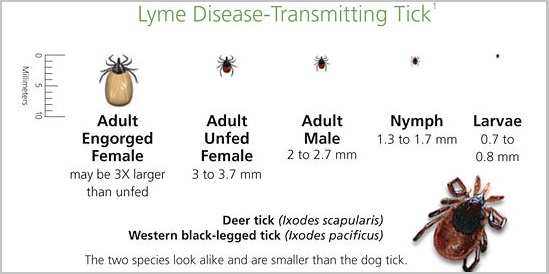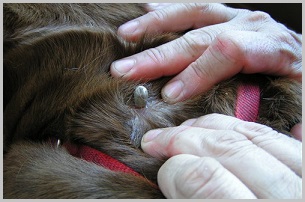Table Of Contents
 Canine Lyme Disease : Case of Golden Retriever Dogs
Canine Lyme Disease : Case of Golden Retriever Dogs
Canine Lyme disease is becoming a growing problem in many parts of the United States. So let's talk about what it is, and what you can do about it.
A Little Bit of Lyme Disease History
Lyme disease was named for the town of Lyme, Connecticut.
That's where the first human cases were diagnosed in 1977.
The first case of canine Lyme disease was reported in 1984.
This disease is found today in every area of the United States.
It is endemic (always present) on the east coast, west coast and upper Midwest. It can also be found in several areas of Europe and Asia.
What Causes Canine Lyme Disease?

To be more precise, ticks don't actually cause the disease--they're just the carriers.
The bacterium that causes Lyme disease is a spiral shaped organism called Borrelia burgdorferi.
The ticks feed on smaller critters (often the white-footed mouse) that are infected, then move on to bigger prey. That's usually deer, but they're not fussy. Either dogs or people will do just fine.
After the tick's been drinking its victim's blood for 24 to 48 hours, it injects a substance into the blood to keep it from getting too thick. That's when the disease-causing organisms get injected into the victim, too.
So you have a small window of opportunity (24 to 48 hours) to get ticks off your dog (or yourself) before the disease is transmitted.
Unfortunately, these ticks are smaller than the head of a pin, so they're easy to miss.
Not every deer tick harbors canine Lyme disease--only about 10 to 50 percent of them do, depending on the part of the country they live in. Those still aren't very good odds for your dogs and you.
Signs and Symptoms of Lyme Disease in Dogs
Symptoms may not show up immediately after an infected tick steals a meal from your Golden Retriever. In fact, dogs can harbor the organisms for several months before the first symptoms of Lyme disease appear.
The telltale Lyme disease bullseye rash that shows up on people is quite rare on dogs. But here are the most common canine Lyme disease symptoms to watch for:
- Swollen, painful joints
- Lameness
- Fever
- Loss of appetite
- Lethargy
- Swollen lymph nodes
[AdSense-A]
Diagnosing Canine Lyme Disease
How is Lyme disease diagnosed?
It's difficult to diagnose Lyme disease in canines because the symptoms mimic many other problems.
Your veterinarian will try to reach a diagnosis by:
- Asking you if your dog's been in an endemic area
- He could have been exposed to a deer tick while visiting
- Performing a physical exam to look for typical clinical signs
- Drawing blood in order to perform a special test
Until recently, vets found it nearly impossible to determine if the presence of antibodies to Borrelia burgdorferi were caused by an earlier vaccination or by the actual infection.
A new canine Lyme disease test--called a C6 ELISA--is now available which provides information about three diseases--heartworm (carried by mosquitoes), canine Ehrlichiosis and canine Lyme disease (both of which are carried by ticks).
This new test is unique in that it can determine whether the antibody was produced in response to active infection or by vaccination, making it much easier to make an accurate diagnosis.
Treating Canine Lyme Disease

The best treatment for Lyme disease in dogs is a round of antibiotics. The antibiotic doxycycline is relatively inexpensive and has limited side effects for dogs.
Most vets prefer doxycycline because it also successfully treats several other tick-borne diseases that may be causing these symptoms. Amoxicillin and tetracycline are other frequently used antibiotics for Lyme disease.
Fortunately, over ninety percent of dogs treated within the first week of obvious symptoms will respond rapidly to antibiotic treatment, often within 2 to 5 days.
Canine Lyme Disease Prognosis
The prognosis for dogs with canine Lyme disease is very good. But it's really important to finish out the full term of the prescribed antibiotic therapy. Don't stop early, just because your dog seems to be well.
According to canine Lyme disease statistics, about five percent of dogs will have some type of relapse--with later symptoms of Lyme disease in the form of heart or nerve damage--even after treatment.
Some of these dogs will experience chronic Lyme disease symptoms of lifelong joint pain from the damage caused by the bacteria. That's why the sooner treatment is started, the better the dog's chances of a complete recovery.
[AdSense-A]
Canine Lyme Disease Prevention
The question of how to prevent Lyme disease in dogs is one asked by all dog owners who live in areas where ticks may be found.
Here are some ways to reduce the chance of ticks feasting on your dog:
- Use insecticides on the yard around your house
- Check your dog for ticks every time he comes back into the house
- Remove ticks from dog carefully with tweezers, and apply an antiseptic to the spot where the tick was dining
- Discuss tick preventives and repellents with your veterinarian
- A monthly medication (applied between the shoulders) combined with a prescription-strength tick collar have been shown to be quite successful when used together
- If you use a topical once-a-month tick product, always consult your veterinarian before applying any additional repellent product
- Insect repellents designed to be applied to clothing should not be used on dogs
- If you own a kennel, check with your veterinarian about tick control measures specially designed for kennels
Use of the current canine Lyme disease vaccine is still being debated. It's not 100 percent effective, and it only prevents infection in dogs vaccinated before any exposure to Lyme organisms.
That means it only helps puppies and dogs from non-Lyme areas traveling to Lyme areas. Annual boosters are needed to continue the vaccine-based immunity.
Opponents of the vaccine argue that Lyme disease is an infection for which over 90 percent of infected dogs will never even get sick anyway.
And the 5 to 10 percent that do get sick can be easily treated with a safe, inexpensive course of antibiotics. This is an issue you may want to discuss with your vet.
Can Canine Lyme Disease Be Spread By My Dog?
Are you wondering if you can get it from your dog? In other words, is Lyme disease contagious?
While you can't actually catch Lyme disease from your dog, you could get the disease if your dog is harboring an infected tick and that tick bites you, too. That's why it's really important to try to keep ticks off your dog and to check yourself for ticks frequently.
Other dogs in your household can contract Lyme disease from ticks that are still prowling around on the infected dog. So watch out for those pesky ticks, and dispose of them promptly.
[AdSense-A]
Similar Articles :
1- Tramadol For Dogs Toxicity.
2- Golden Retriever Lifespan .
3- Can Dogs Eat Grapes Or Not?? .
4- How To Stop Your Dog From Biting .
5- Golden Retriever Health Problems Issues.
6- Find Good Golden Retriever Forum.
7- How To Deal With An Golden Retriever Dog..
8- My Dog Ate Chocolate What Should I Do? .
9- Worming / Deworming Your Golden Retriever Puppies.
10- Golden Retriever Breed Standard.
10- How To Deal With An Aggressive Golden Retriever Dog.
11- How To HOW TO STOP YOUR DOG FROM BITING.
12-The Rabies Reality : Are Golden Retrievers Susceptible To Rabies
13- The Phases Of Rabies & Preventative Measures For Golden Retrievers
 Canine Lyme Disease : Case of Golden Retriever Dogs
Canine Lyme Disease : Case of Golden Retriever Dogs